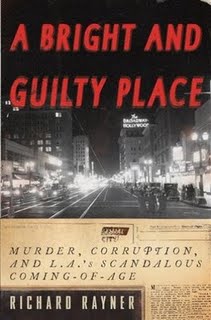Rayner’s history of 1920s and ‘30s Los Angeles is wrapped, naturally, around corruption and reinvention. Leslie White is an investigator for the D.A.’s office who becomes a pulp author. (When he needs help breaking into the racket, he gets in touch with his old lawyer friend Erle Stanley Gardner.) Dave Clark is a golden boy war hero turned prosecutor who ends up charged with the murder of L.A.’s criminal kingpin. The book brims with fascinating information, but it’s also disjointed. There are a few scandals too many. The lives of the two central figures don’t have that much overlap. Clark’s trial is anticlimactic while the bizarre events in its wake are treated as an afterthought. Raymond Chandler is frequently cited even though his relation to the proceedings is tangential.
The book brims with fascinating information, but it’s also disjointed. There are a few scandals too many. The lives of the two central figures don’t have that much overlap. Clark’s trial is anticlimactic while the bizarre events in its wake are treated as an afterthought. Raymond Chandler is frequently cited even though his relation to the proceedings is tangential.
Ultimately it’s Chandler’s vision of Los Angeles, seductive and treacherous, that Rayner understands intuitively and captures very well. For all its flaws as a history of a time, the book succeeds as a chronicle of a mood. Many people have contrasted Rayner’s book with L.A. Noir by John Buntin, which picks up the City of Angels’ story where Rayner leaves off. Rayner’s book is better written, Buntin’s more cohesive. Together they offer a compelling account of Los Angeles as it was not only inventing itself, but 20th century America.
Some of White’s stories are collected in The Black Lizard Big Book of Pulps. I’ll say this for them: they have a certain energy. Here’s the opening line from “The City of Hell!,” published in the October 1935 issue of Black Mask and influenced by L.A.’s endemic graft.
The piercing screams of a woman filled the awed hollow of silence left void by the chatter of a sub-machine-gun and acted as a magnet of sound to suck the big squad car to the scene.
Rayner recently led the Guardian on a tour of locations from the book. And here he is on Ben Hecht.
skip to main |
skip to sidebar
Twitter

Movies. Crime fiction. Baseball. Jazz. Cocktails.
MY SUBSTACK
Subscribe to Cocktails and Crime: https://vincekeenan.substack.com/
About Me
- Vince
- One-half of classic Hollywood mystery writer Renee Patrick (DESIGN FOR DYING, DANGEROUS TO KNOW, SCRIPT FOR SCANDAL, THE SHARPEST NEEDLE, IDLE GOSSIP). Tippling gadabout. Author of DOWN THE HATCH: ONE MAN'S ONE YEAR ODYSSEY THROUGH CLASSIC COCKTAIL RECIPES AND LORE, available at Amazon. Editor, the Film Noir Foundation's NOIR CITY magazine.
Email Me!
vince (at) vincekeenan (dot) com
Blog Archive
-
▼
2010
(117)
-
▼
January
(9)
- On The Web: Lem Dobbs
- Book: The Writing Class, by Jincy Willett (2008)
- TV: The Greatest Broadcast in the History of the M...
- Movie: Big Fan (2009)
- Book: Devil’s Garden, by Ace Atkins (2009)
- Movie: Best Seller (1987)
- Upcoming: Noir City 8
- Book: A Bright and Guilty Place, by Richard Rayner...
- Movie: District 13: Ultimatum (U.S. 2010)
-
▼
January
(9)